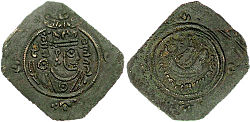Schahrbaraz
Farruchan († 630 ), better known by his nickname Schahrbaraz , which means something like "the royal boar" ["boar of the empire"], was a Persian general ( Spahbod ) and usurper in the 7th century .
He fought for the Sassanid king Chosrau II successfully against the East Romans and conquered Damascus in 613 and Jerusalem in 614 , where numerous Christians were killed and several churches in the city, such as the Church of the Holy Sepulcher , the Basilica of Hagia Sion and the Church of St. Mary on the site of the later al-Aqsa Mosque , were destroyed (see also Roman-Persian Wars ). Finally, he continued the alleged “ Holy Cross ” to Persia, which left a clear shock effect on Christians. Chosrau gave him the nickname for his aggressive manner of waging war.
In the war against Emperor Herakleios he was initially defeated by this in 622 (or 623, probably in Cappadocia ). In 625 Herakleios succeeded again in evading the grasp of Shahrbaraz and General Shahin , a rival of Shahrbaraz '. Schahrbaraz stood with a large army in Chalcedon on the Bosphorus in 626 , while the Avars besieged Constantinople , which failed, however, because the Romans were able to prevent a union of Persians and Avars. In the following two years, Shahrbaraz apparently stayed largely out of the war, not least because of the irascible accusations of Chosrau.
After the fall of Chosraus and the peace agreement with Ostrom, the Persians had to evacuate the occupied territories, but this process evidently dragged on. In July 629, however, Shahrbaraz came to an understanding with Emperor Herakleios and they entered into a pact. 630 Shahrbaraz killed King Ardashir III. and made himself the great king . However, he found no support in the empire, as he did not belong to the ruling house of the Sassanids and was murdered after only a short reign (April to June 630). To make matters worse, the plague raged in Ctesiphon during his brief reign .
According to several sources, he had previously accepted the Christian faith at some point; in which case he would have been the first and only Persian great king who was not a Zoroastrian . His son with the Greek name Niketas was certainly baptized and served for some time in the Eastern Roman military after the murder of his father, before retiring to Emesa after the lost battle of Yarmuk , in which he commanded parts of the imperial troops, and finally from the victorious Arabs was executed.
literature
- Walter Kaegi, Paul M. Cobb : Heraclius, Shahrbaraz, and al-Tabari . In: Hugh Kennedy (Ed.): Al-Tabari. A Medieval Muslim Historian and His Work . The Darwin Press, Princeton 2008, pp. 95-112.
- John Martindale: The Prosopography of the Later Roman Empire IIIb . Cambridge 1992, pp. 1141-1144.
- Klaus Schippmann : Basic features of the history of the Sassanid Empire . Darmstadt 1990.
Remarks
- ↑ See Ferdinand Justi: Iranisches Namenbuch. Marburg 1895, pp. 277f.
- ↑ On the Persian War cf. Walter E. Kaegi: Heraclius. Cambridge 2003; on the Schahrbaraz campaigns see ibid., p. 77ff.
- ↑ See the explanations in the anonymous West Syrian Chronicle of 1234 ; engl. Translation in: Andrew Palmer / Sebastian P. Brock / Robert G. Hoyland : The Seventh Century in the West Syrian Chronicles . Translated Texts for Historians . Liverpool University Press, Liverpool 1993, pp. 121f.
- ^ Walter E. Kaegi: Heraclius. Cambridge 2003, pp. 187f.
- ↑ See also the explanations in the universal history of the Tabari : Theodor Nöldeke: History of the Persians and Arabs at the time of the Sasanids. From the Arab Chronicle of Tabari. Translated and provided with detailed explanations and additions. Leiden 1879, p. 388ff.
| predecessor | Office | successor |
|---|---|---|
| Ardashir III. |
King of the New Persian Empire 630 |
Borane |
| personal data | |
|---|---|
| SURNAME | Schahrbaraz |
| ALTERNATIVE NAMES | Farruchan |
| BRIEF DESCRIPTION | Persian general and great king |
| DATE OF BIRTH | 6th century |
| DATE OF DEATH | 630 |
